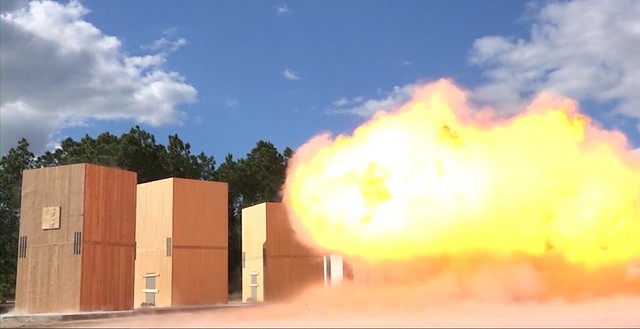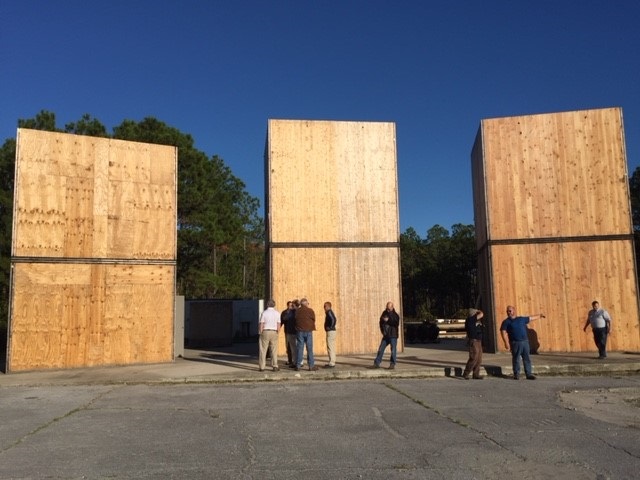
At the USDA Forest Service’s Forest Products Laboratory (FPL), researchers sometimes get a little destructive. They bend and break wood samples of all sizes, and even shoot lumber out of a cannon at 100 miles per hour.
But explosions? That’s a bit out of their wheelhouse. Not that wood can’t handle it. Particularly when it’s used in engineered products like cross-laminated timber, or CLT, which FPL researchers have studied from many angles, including fire performance, use in earthquake-prone regions, and the effects of moisture on CLT. Made of alternating layers of dried lumber boards stacked at 90-degree angles, CLT is exceptionally strong and stable and can be used as walls, roofs, and floors in mid-rise buildings.
Recent tests of CLT structures show just how tough this material can be. In 2016 the Forest Service Wood Innovations program initiated live blast testing of CLT by Woodworks at Tyndall Air Force Base in Panama City, Florida. Based on the successful results of that testing, the Forest Products Lab, in cooperation with Woodworks and the Softwood Lumber Board, led a second round of live blast testing in 2017.

The objective of these studies was to demonstrate the capability of CLT structures to resist airblast loads, thereby allowing the military to incorporate mass timber materials like CLT into their construction projects. The structures survived blasts with charges large enough to potentially cause lethal injuries.
Tests were performed on three structures two stories high, each made of a different grade of CLT, all including window and door openings. The first set of tests were conducted under the structures’ own self-weight. For the second set, a load was applied to simulate the conditions associated with a five-story residential or office building. For some tests, variables in CLT panels and fasteners were altered.
The tests covered a spectrum of blast loads, and the results are promising. After the first set of tests, all structures remained intact, and the levels of damage were acceptable and matched what models predicted. All three structures remained standing after the second tests as well, even after the last blast that was intended to take the structures well beyond their design intent. Panel rupture was expected and observed, but the buildings remained intact and safe to enter.
To view all the first-round tests, you can watch WoodWorks’ CLT Massive Wall Blast Tests and you can watch our favorite - WoodWorks’ CLT Blast Testing: Test 3. While not a dramatic view of the explosion itself, this high-speed shot shows the wood panels moving with the force of the blast without being destroyed.

The results of these studies will be used to further expand the use of wood solutions for Department of Defense applications and other blast-resistant construction. The information gathered will allow engineers to use mass timber solutions where they were not previously permitted, potentially increasing market share for wood-based materials.
The Forest Service plays a lead role in researching and promoting CLT in the U.S. to open up new markets for wood products. Using smaller wood that might serve as fuel for wildfires as building materials helps reduce the damage posed by forest fires while bringing jobs back to rural communities.

